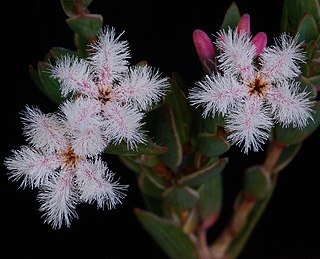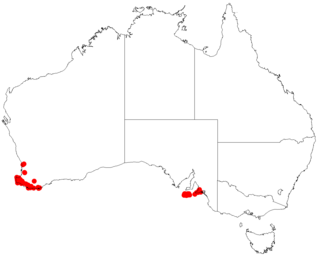
Allocasuarina lehmanniana, commonly known as dune sheoak, is a species of flowering plant in the family Casuarinaceae and is endemic to near-coastal areas of the south-west of Western Australia. It is dioecious or less commonly a monoecious shrub that has its leaves reduced to scales in whorls of six to eight, the mature fruiting cones 12–35 mm (0.47–1.38 in) long containing winged seeds (samaras) 4.0–5.5 mm (0.16–0.22 in) long.

Grevillea petrophiloides, commonly known as pink pokers, rock grevillea or poker grevillea, is a species of flowering plant in the family Proteaceae and is endemic to the south-west of Western Australia. It is an erect shrub with divided leaves, the lobes mostly linear, and cylindrical clusters of usually pink to reddish pink and bluish-grey flowers.

Eremophila lehmanniana is a flowering plant in the figwort family, Scrophulariaceae and is endemic to Western Australia. It is an erect shrub, usually with short, wide, serrated leaves and white to lilac-coloured flowers. It occurs in the south west of Western Australia.

Conospermum amoenum, commonly known as blue smokebush, is a species of flowering plant in the family Proteaceae and is endemic to the south-west of Western Australia. It is an erect or spreading shrub with linear leaves, and spikes of blue or white tube-shaped flowers.

Conospermum canaliculatum is a species of flowering plant in the family Proteaceae, and is endemic to the south-west of Western Australia. It is a dense, multistemmed, erect shrub with linear leaves and spike-like panicles of woolly white, tube-shaped flowers.

Daviesia nudiflora is a species of flowering plant in the family Fabaceae and is endemic to the south-west of Western Australia. It is a bushy shrub with sharply pointed, egg-shaped to elliptic or oblong phyllodes, and yellow-orange flowers with reddish-brown markings.

Boronia juncea is a plant in the citrus family, Rutaceae and is endemic to the far south-west of Western Australia. It is an erect shrub with linear, short-lived leaves and groups of up to eight white to pink, four-petalled flowers.

Daviesia hakeoides is a species of flowering plant in the family Fabaceae and is endemic to the south-west of Western Australia. It is a shrub with many tangled stems, scattered sharply-pointed phyllodes and yellow or orange and dark red flowers.

Daviesia decurrens, commonly known as prickly bitter-pea, is a species of flowering plant in the family Fabaceae and is endemic to the south-west of Western Australia. It is spreading, erect, or low-lying shrub with scattered, sharply-pointed, narrow triangular phyllodes, and yellowish pink and velvety red flowers.

Brachyloma preissii is a species of flowering plant in the heath family, Ericaceae, and is endemic to Western Australia. It is an erect, dense shrub with linear to oblong leaves and red, or pinkish-red, tube-shaped flowers.

Leucopogon elegans is a species of flowering plant in the heath family Ericaceae and is endemic to the south-west of Western Australia. It is a spreading shrub with egg-shaped leaves, and white or pink, tube-shaped flowers densely bearded on the inside.

Leucopogon hirsutus is a species of flowering plant in the heath family Ericaceae and is endemic to southern continental Australia. It is a low-lying or straggling shrub with elliptic to oblong leaves and inconspicuous, white, bell-shaped flowers.

Pimelea lehmanniana is a species of flowering plant in the family Thymelaeaceae and is endemic to the southwest of Western Australia. It is a shrub with narrowly egg-shaped leaves and clusters of white to pale yellow flowers surrounded by 4 or 6, pale yellowish-green involucral bracts.

Conostephium preissii is a species of flowering plant in the family Ericaceae and is endemic to the southwest of Western Australia. It is an erect shrub with many stems, egg-shaped to oblong leaves and white and purplish to reddish-pink flowers.
Caladenia nana, commonly known as pink fan orchid, is a plant in the orchid family Orchidaceae and is endemic to the south-west of Western Australia. It is a clump-forming ground orchid with a single linear leaf and up to 6 pale pink to rose pink flowers.

Billardiera lehmanniana, commonly known as kurup, is a species of flowering plant in the family Pittosporaceae and is endemic to Western Australia. It is a glabrous shrub or climber that has linear to oblong leaves with the edges curved upwards and large groups of flowers with widely spreading pale mauve petals that darken as they age.

Styphelia microcalyx, commonly known as native cranberry, is a species of flowering plant in the heath family Ericaceae and is endemic to the south west of Western Australia. It is a much-branched, erect or diffuse shrub with linear or narrowly oblong leaves and red, tube-shaped flowers that are bearded inside.

Andersonia brevifolia is a species of flowering plant in the family Ericaceae and is endemic to the south-west of Western Australia. It is an erect shrub with egg-shaped leaves and white or pink flowers.

Andersonia heterophylla is a species of flowering plant in the family Ericaceae and is endemic to the south-west of Western Australia. It is an erect or ascending shrub with egg-shaped to more or less linear leaves and white or pink flowers.

Andersonia involucrata is a species of flowering plant in the family Ericaceae and is endemic to the south-west of Western Australia. It is a compact or straggling, spreading shrub with pointed egg-shaped to lance-shaped leaves and white or pink flowers.



















